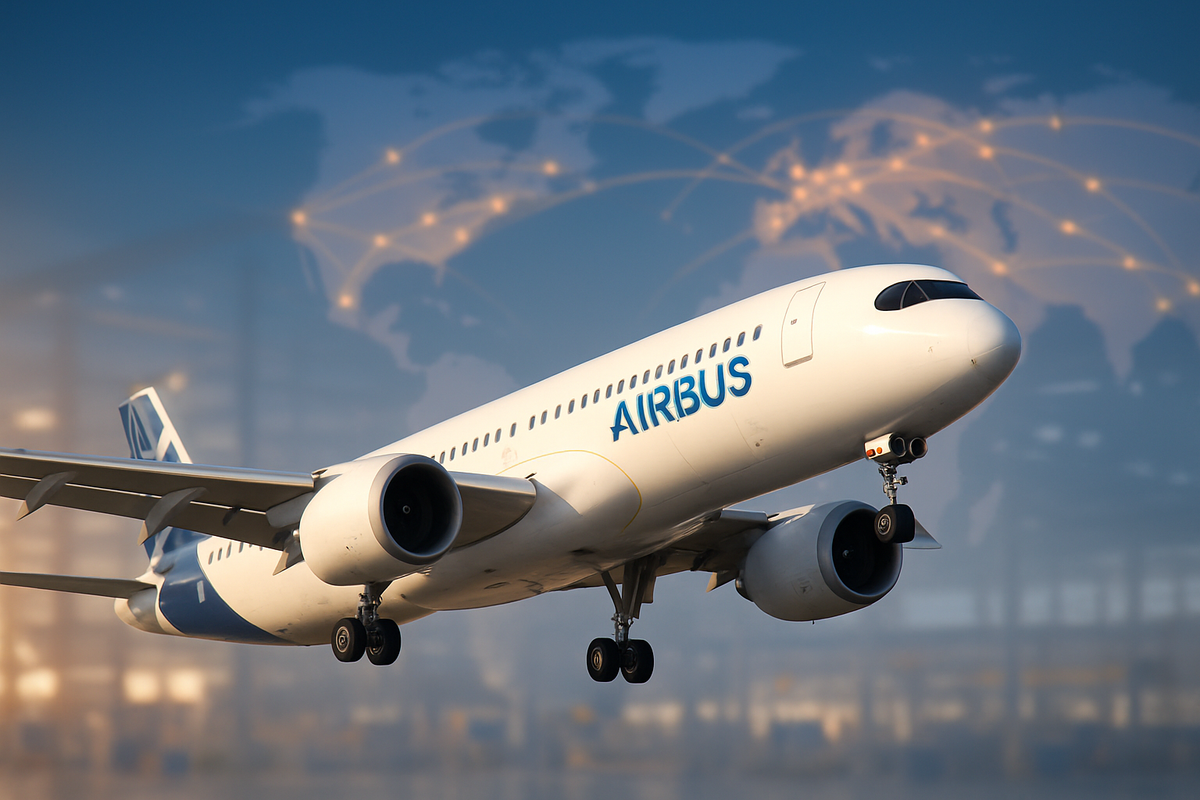
Toulouse, France – Airbus (EPA: AIR) has reported a robust performance in the first nine months of 2025, delivering 507 commercial aircraft and affirming its dominant position in the global aviation market. This significant milestone was underscored by a record-breaking September, where the European aerospace giant handed over 73 jets, indicating a notable improvement in crucial engine supply chains. The strong delivery figures place Airbus firmly on track to achieve its ambitious full-year target of approximately 820 aircraft, further widening its lead over rival Boeing (NYSE: BA).
The 507 deliveries from January to September mark an increase from the 497 aircraft delivered during the same period in 2024, demonstrating a consistent upward trajectory despite ongoing industry challenges. This impressive output comes as Airbus continues to navigate a complex operating environment, particularly concerning engine delivery delays from key suppliers like CFM International (a joint venture of GE Aerospace (NYSE: GE) and Safran (EPA: SAF)) and Pratt & Whitney (a division of RTX Corporation (NYSE: RTX)). However, the recent surge in deliveries, coupled with a reported decrease in "gliders" – fully assembled aircraft awaiting engines – suggests that these supply bottlenecks are easing.
Detailed Coverage: Airbus's Resilient Ascent Amidst Headwinds
Airbus's provisional 507 commercial aircraft deliveries in the first nine months of 2025 represent a 2% increase from the 497 deliveries in the same period of 2024. This cumulative figure turned positive in September 2025, surpassing the equivalent total for 2024 for the first time. September itself was a record-breaking month for Airbus, with approximately 73 jets delivered, up from 50 deliveries in September 2024 and exceeding earlier analyst forecasts. This strong performance signals Airbus's improved capacity to meet its full-year delivery target of around 820 commercial aircraft across all models by year-end.
Despite this impressive output, Airbus continues to grapple with significant supply chain issues, particularly concerning engine availability. Both CFM International and Pratt & Whitney have faced difficulties in ramping up output due to lingering labor shortages, production difficulties, and component availability issues. Pratt & Whitney's GTF (geared turbofan) engines, especially for the A320neo family, have experienced complications stemming from a metal powder defect, leading to a large-scale recall and the grounding of hundreds of aircraft. CFM International has also encountered production difficulties, contributing to shortages that persisted into 2025. These engine bottlenecks have significantly constrained Airbus's ability to accelerate production, despite robust demand for its aircraft.
Earlier in 2025, Airbus faced a growing backlog of "gliders" – fully assembled aircraft awaiting engine installation – with reports indicating up to 60 units parked outside its factories by July, absorbing approximately €1 billion in inventory costs. However, recent indications suggest that the "glider" issue has started to ease, with the number reportedly dropping from its peak. This improvement, coupled with the strong September delivery numbers, is crucial for Airbus to meet its delivery targets and reduce financial strain from incomplete aircraft. Airlines, in some cases, have even accepted "glider" deliveries due to the scarcity of delivery slots, underscoring the immense value of a confirmed production slot in a sold-out market.
A historic milestone was reached on October 7, 2025, when the Airbus A320 family officially surpassed the Boeing 737 to become the world's most delivered commercial jet. This achievement was sealed with the delivery of an A320neo to Saudi carrier flyadeal, pushing the total number of A320 family deliveries to 12,260 aircraft since its entry into service in 1988. This compares to Boeing's 737 series, which had approximately 12,259 units delivered. This marks the first time since 1968 that Boeing has been dethroned in the single-aisle market, a testament to the A320's consistent innovation, fuel efficiency, and versatility.
Market Ripple Effects: Winners and Losers in the Aerospace Duopoly
Airbus's sustained strong delivery performance presents a considerable challenge to its primary competitor, Boeing (NYSE: BA), primarily impacting its market share and financial standing. Airbus has delivered more aircraft than Boeing for five consecutive years, a trend that intensified in 2024, where Airbus delivered 766 commercial aircraft, more than double Boeing's 348 deliveries. This disparity has led to Boeing reporting losses since 2019 and a significant drop in its stock performance. Boeing is under immense pressure to recover from production challenges and quality issues, forcing it to cede market share, particularly in single-aisle aircraft where Airbus now holds a dominant lead.
The two primary engine suppliers for commercial aircraft, CFM International (a joint venture between GE Aerospace (NYSE: GE) and Safran (EPA: SAF)) and Pratt & Whitney (a division of RTX Corporation (NYSE: RTX)), experience varying impacts from Airbus's success. CFM International, whose LEAP-1A engine powers a significant portion of the A320neo family, directly benefits from Airbus's high delivery volumes, driving revenue and profitability for its parent companies. CFM continues to lead in the narrowbody market, with its LEAP series powering 72% of active narrowbody fleets overall.
Conversely, Pratt & Whitney, while also benefiting from Airbus's high delivery volumes for its GTF engines, has faced significant financial impacts due to reliability issues. The 2023 requirement for accelerated inspections on 600-700 PW1100G engines resulted in an estimated gross financial implication of $6-7 billion for RTX, with a $3 billion pre-tax operating profit charge. Pratt & Whitney is focused on resolving these reliability issues to maintain its market share and reputation, especially as its GTF engine is also used on the Airbus A220.
Airline customers are directly affected by these dynamics. Airlines with significant existing Airbus fleets or those ordering new Airbus aircraft stand to "win" from fleet commonality, reduced training costs, and the A320neo's fuel efficiency. In an environment where Boeing has faced significant production delays, Airbus's more consistent delivery schedule offers a reliable path for airlines to update their fleets with fuel-efficient aircraft. Conversely, airlines heavily reliant on Boeing, or those facing delays in receiving their ordered aircraft, might experience disadvantages, forced to fly older, less fuel-efficient planes for longer periods, increasing operational costs.
Wider Significance: Reshaping the Aerospace Landscape
Airbus's strong market position and delivery performance underscore a significant shift in the aerospace duopoly, driven by prevailing industry trends. The sustained demand for more fuel-efficient aircraft, fueled by environmental concerns and rising fuel costs, has been expertly leveraged by Airbus with its A320neo family. This family offers 15-20% less fuel burn, aligning with airlines' pursuit of lower operating expenses and the industry's decarbonization goals. The A320 family's historic achievement of surpassing the Boeing 737 as the most-delivered jetliner in history further solidifies Airbus's dominance in the crucial single-aisle market, which forms the backbone of most airline fleets.
The ripple effects extend profoundly to its main competitor, Boeing. Boeing's recent challenges, including the 737 MAX groundings, ongoing safety and certification issues, and production bottlenecks, have directly contributed to Airbus's market share gains. While Airbus produced 58 A320neos per month in July 2025, Boeing was producing only 38 737 MAX units, highlighting the disparity. This situation has compelled Boeing to focus on recovery and quality, impacting its own market standing and pushing both giants to navigate complex supply chain and regulatory landscapes.
The competition between Airbus and Boeing also carries significant regulatory and policy implications, primarily manifested in long-running trade disputes. The US and EU have been engaged in the world's longest-running trade dispute at the WTO concerning alleged illegal government subsidies to both manufacturers. While tariffs were suspended in 2021, the underlying issue of state support remains a contentious geopolitical dimension of the duopoly, highlighting how governments actively support their national champions. The effective duopoly itself, accounting for 99% of global large aircraft orders, raises questions about market concentration and potential antitrust enforcement.
Historically, the current duopoly emerged from industry consolidation, with Airbus formed to challenge American dominance after mergers. The duopoly has maintained its strength by absorbing or partnering with smaller competitors, as seen with Airbus's acquisition of a majority stake in Bombardier's CSeries program (now the Airbus A220). The competition also echoes past product line rivalries, such as the Boeing 747 versus the Airbus A380, demonstrating that even within a duopoly, misjudging market needs and cost-effectiveness can have significant consequences. Boeing's current struggles with the 737 MAX similarly illustrate the high stakes of product development and safety in such an environment.
What Comes Next: Navigating Growth and Transformation
Airbus is strategically positioned for future growth, leveraging its strong delivery performance and substantial order backlog. The company aims to increase the production of its A320 family aircraft to 75 per month by 2027, up from an unofficial rate of around 52 per month in late 2024. To achieve this, Airbus is expanding its global production footprint by opening new final assembly lines (FALs) in Mobile, Alabama, and Tianjin, China, both scheduled for October 2025. These expansions are expected to contribute significantly to its global output, with U.S. and China production capacity each accounting for 20% by 2026.
In the short term, Airbus will capitalize on its current market leadership and a robust order backlog, which for the A320 family alone exceeds 7,000 jets, representing over 12 years of production. The ongoing recovery in air travel further fuels demand for new aircraft. However, significant short-term challenges persist, primarily supply chain disruptions affecting critical components like engines, semiconductors, and wiring harnesses. These issues have forced Airbus to revise production targets and have resulted in a backlog of completed airframes awaiting missing parts, with delivery delays expected to persist for at least three years.
Long-term possibilities for Airbus are largely shaped by decarbonization efforts and technological innovation. Airbus aims to bring the world's first zero-emission commercial aircraft to market by 2035, investing over €2 billion per year in cleaner technologies such as hybrid-electric engines and hydrogen propulsion. The company is actively pursuing 100% Sustainable Aviation Fuel (SAF) compatibility for its entire range of commercial airliners before 2030. These ambitions open up new markets and position Airbus as a leader in sustainable aviation. However, long-term challenges include the significant R&D investment required, the development of necessary infrastructure for new fuels, and managing the complex transition to a decarbonized aerospace sector.
Airbus's strategic pivots are centered on resilience, innovation, sustainability, and scale. This involves strengthening supply chain resilience through diversification and deeper collaborations with suppliers, addressing workforce development, and continuing heavy investment in next-generation aircraft and sustainable technologies. The company's ambition to replace the A320 with an open-fan propulsion jet by 2035 demonstrates a radical commitment to innovation for emissions reduction. While Boeing is expected to recover its shipment volume and regain some market share (projected around 40% in 2025), Airbus is anticipated to continue its strong delivery performance, with competition intensifying around the introduction of next-generation, more sustainable aircraft.
Comprehensive Wrap-up: Sustained Leadership in a Transforming Market
Airbus's robust delivery performance in the first nine months of 2025, culminating in over 500 jet deliveries and a record-breaking September, solidifies its position as the undisputed market leader in commercial aviation. The key takeaway is Airbus's operational resilience and strategic foresight in navigating a complex global environment marked by persistent supply chain challenges. The A320 family's historic milestone of surpassing the Boeing 737 in total deliveries underscores the enduring success of Airbus's narrowbody strategy and its focus on fuel efficiency.
Moving forward, the aerospace market is poised for sustained growth, driven by increasing air travel demand and an urgent need for fleet modernization. Airbus is exceptionally well-positioned to capitalize on this, thanks to its substantial order backlog and aggressive production ramp-up plans. The company's strategic expansion of its global production footprint, with new Final Assembly Lines in the US and China, is crucial for meeting demand, building resilience, and mitigating geopolitical risks. This globalized approach enhances flexibility and shortens delivery times for customers, further solidifying Airbus's long-term impact on air travel.
The lasting impact of Airbus's current trajectory is the reshaping of the aerospace duopoly. While Boeing (NYSE: BA) faces continued pressure from production delays and quality control issues, Airbus's consistent performance and innovative strides in sustainable aviation are widening the competitive gap. This leadership not only affects market share but also drives the entire industry towards decarbonization through significant investments in hybrid-electric, hydrogen, and SAF-compatible aircraft.
Investors should closely monitor Airbus's ability to meet its ambitious 2025 delivery target of around 820 commercial aircraft, as this will be a key indicator of its success in mitigating ongoing supply chain bottlenecks, particularly engine deliveries. Progress on the production ramp-up for all aircraft families, especially the A350, and the profitability of these efforts will also be critical. Beyond commercial aircraft, the performance of Airbus's Defence and Space and Helicopters divisions will be important for overall financial health. The upcoming financial reports will provide further insights into the company's operational achievements and strategic direction in the months to come.
This content is intended for informational purposes only and is not financial advice.
Disclaimer: This article is based on information available as of October 8, 2025. Market conditions and company performance are subject to change.





